If you are a Dasher trying to figure out the answer to the “Earn by time vs. Earn by offer” debate, you are not alone. There are so many different types of markets and the answer to the question “Is DoorDash Earn by time is worth it” is not one-size-fits-all.
Dashers are always debating about the pros and cons of this relatively new method (Earn by time) introduced by DoorDash.
With “Doordash earn by time,” you get a guaranteed hourly rate for the time you spend on active deliveries. It’s a predictable way to earn, but does it stack up against “Earn per Order,” which pays you for each completed delivery, offering more flexibility?
This article will delve into this crucial question many Dashers have: “Does DoorDash pay hourly or per order, and which is better?”. We’ll explore both these DoorDash earning options, so you can make an informed decision about which route to take.
The answer to this question will vary depending on market conditions and your preferences. We’ll talk about all these variables that can help you choose one over another and how you can switch between “Earn by Time DoorDash” and “Earn per Order”.
So, keep reading to find out how to best maximize your DoorDash earnings.
Is DoorDash “Earn By Time” Worth It?
In my opinion, it’s not worth it for most Dashers in the bulk of the situations, barring a few, because you only get paid for the time between accepting an order and completing the drop-off, not for the return trip or wait time, which devalues the ‘per hour’ earning claim. Many users have reported getting low-tip or no-tip orders that require long drives, making “Earn By Time” less profitable. Some riders have even faced deactivation due to alleged “fraudulent behavior.”

There are restrictions on the number of orders you can decline, typically one per hour, which forces you to accept less lucrative orders.
The inability to preview tip amounts prior to accepting an order also adds a layer of uncertainty to your potential earnings.
While some users find value in the “Earn by Time” model during late-night shifts with long waits at drive-thrus, the overall sentiment leans toward the model not being worth it for consistent income. Plus, if you are trying to up your acceptance rate to become a top Dasher, going by Earn by Time will be a better option.
This is the short summary of my assessment, but if you want to know everything about Earn by Time vs. how it differs from Earn by Offer, keep on reading.
How Does DoorDash Pay Drivers
DoorDash and jobs like it are part of what’s called the “gig economy”, where people take on short-term jobs instead of having a 9-5 job with one employer.
The gig economy gives you more control over when you work, but unlike traditional jobs, don’t expect perks like health insurance or job security.
DoorDash mainly pays their drivers through two ways:
- Earn by time
- Earn by offer
Originally all the Dashers were paid with Earn by offer mode, where each order has its own value and Dashers can choose the order they want to work. Recently DoorDash added in the mix “Earn by time” where Dashers are paid for their active time and have fewer options to choose their orders. Though the reasoning by DoorDash is to provide a reliable source of income, but most Dashers claim it is DoorDash’s way of making people accept low-paying orders.
Is DoorDash earn-by-time worth it or should you opt for earn-per-order?
Or you should hop between them based on what suits you on that particular day?
Let’s dive into the details that will help you figure out which way of earning might suit you better.
Extra Reading: Is DoorDash Worth It Hustle?
What’s “Earn by Time”
With DoorDash’s “Earn by time,” you get paid based on the hours you actively spend on deliveries, not the number of orders you complete.
It eliminates the worry over low-paying or high-mileage orders, you get paid as long as you complete your deliveries on time.
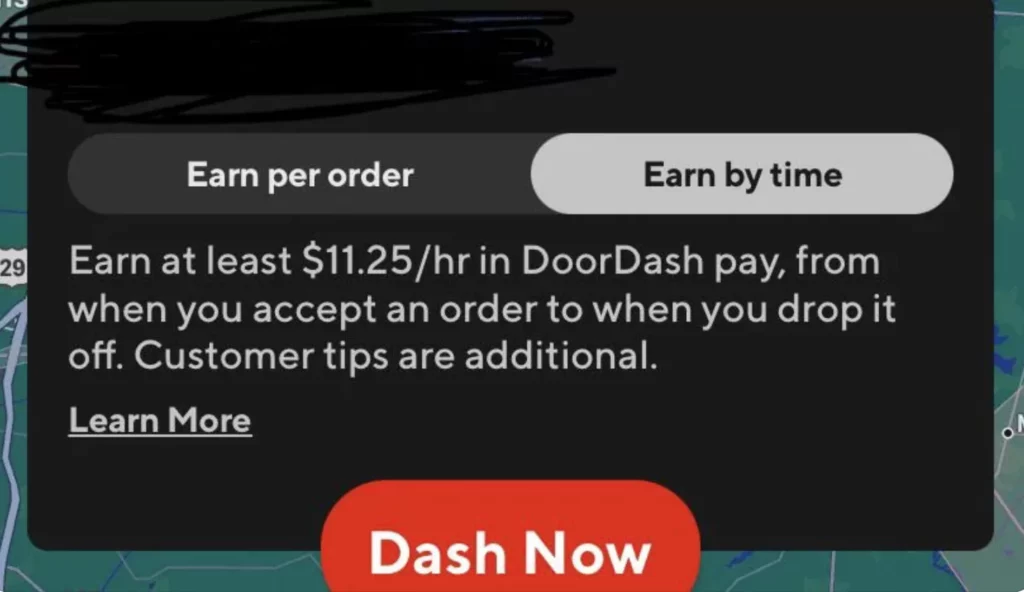
However, this model has a downside: it doesn’t pay you for time while you are waiting for orders or the return trip to your delivery zone. You must also accept nearly every order, limiting the ability to be choosy. You can decline one order per hour and if you decline another, your Dash will end. However, you can start Dash by Offer if that is available at that time.
Your hourly earning rate can vary by city, time of day, and demand but is set before you start your dash and will be the same till you end the dash (barring any boosts that apply only for the applicable time). You also keep 100% of any tips you earn.
Before you dash, you can see what your area’s current hourly rate is. For example, if the rate is $14/hour and you deliver in half an hour, you’ll make $7 from DoorDash, plus tips.
A few Dashers like it due to the reliability of earnings, like this one: “Earn by time gives me peace of mind because I know I’m getting paid hourly, but it does tie me down a bit.”
How’s The Pay?
When you choose DoorDash’s “Earn by time,” here’s how your earnings break down:
- Base Pay: This is the hourly rate DoorDash promises you for each active delivery hour. It varies between $10 to $25 per hour based on a lot of factors like the area you’re working in. You’ll know this base rate before you start your shift.
- Promotions: DoorDash has different types of promotions. For instance, “peak pay” is extra money per hour during busy times. “Challenges” reward you for hitting certain milestones like completing a specific number of deliveries. And sometimes they offer “guaranteed earnings” for working in a particular area for a set time.
- Tips: Customers’ tips come on top of your base pay and promotions. You get all of the tip amount.
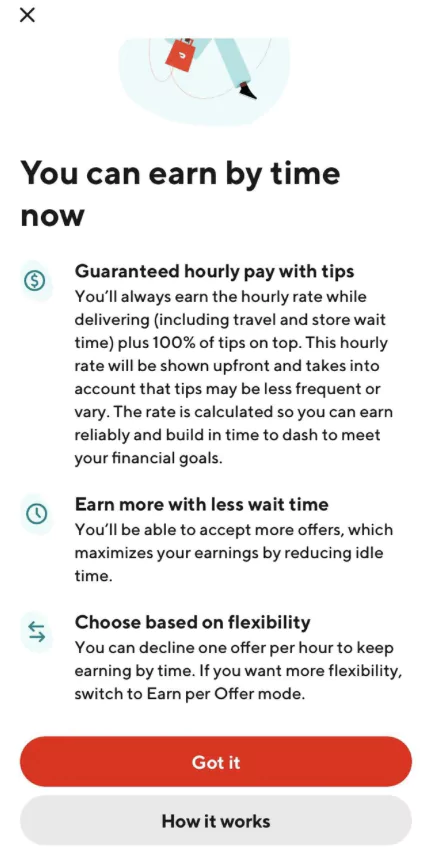
To sum it up, your total earnings per hour equal your base pay plus promotions plus tips. Cash-out options? Fast Pay daily for $1.99, or weekly direct deposit for free.
Note: Most orders chosen by the DoorDash algorithm are low-tip or no-tip orders. But a few Dashers have conspiracy theories that DoorDash themselves withheld the tips on these orders. Like one Reddit user said, “I deliver in my zone for years and when I chose to do Earn by time mode, even my regular does not seem to pay tip, which never happens otherwise. When I turned back to normal mode, tips returned, my hunch is they are keeping the tips.”
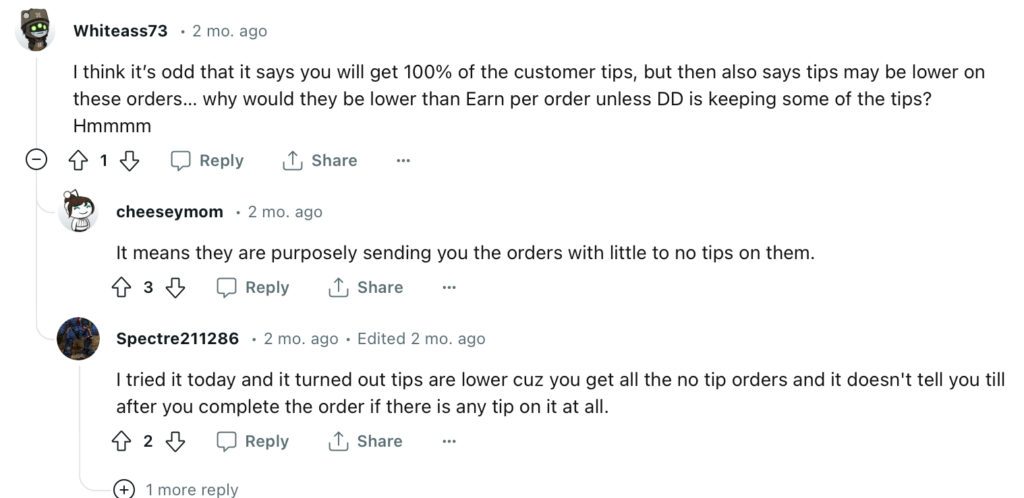
Below are some screenshots of Earn by Time orders, where mostly are no tip orders and it is the issue faced by most users who use this feature. That makes it almost sure, that low or no-tip neglected orders are sent to dashers on Earn by Time, even if they are top dashers.
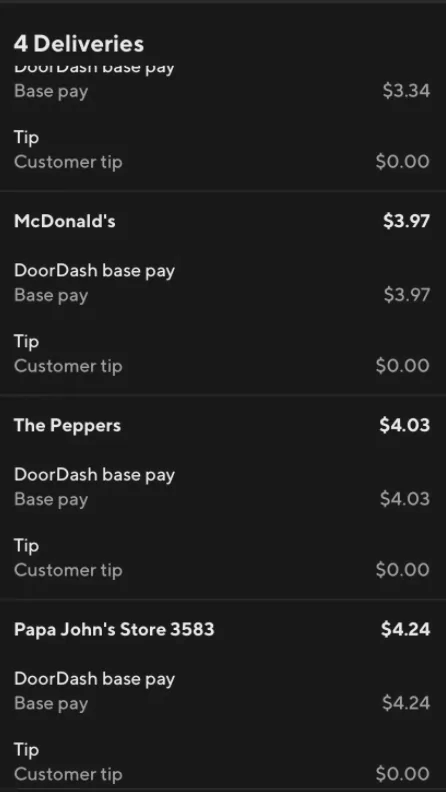
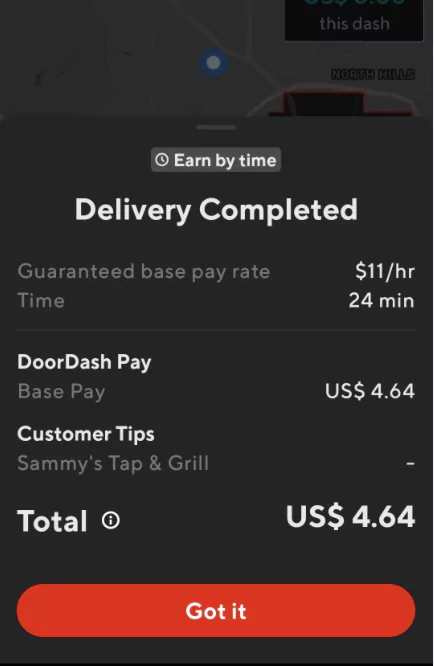
So, if you work in areas where tips are always low, Earn By Time might be a good option, otherwise, you might be missing out on tips, which are the main component of Dasher’s earnings.
Extra Reading: How Much Can You Make Weekly With DoorDash?
Pros and Cons
Pros:
- With DoorDash earn by time, your income is steady and predictable per hour.
- You can earn better in low-tip areas or areas with fast food orders (low-paying).
However, it is not all rosy, as you are missing on your flexibility, as this Dasher suggests: “I do miss the big tips on some of those large orders, though.”
Cons:
- You could lose out on high-paying close-by orders, impacting your “earn per order vs earn by time” decision.
- Lack of upfront earnings info for planning.
- You only earn by time when actively delivering; waiting time isn’t counted.
- You need to keep a high acceptance rate, which could mean taking on more orders.
So, is DoorDash’s “earn by time” worth it? It can offer you a predictable income and more control over your workload.
It’s a unique offering compared to what you’ll find on Uber Eats or Grubhub. Whether to choose “do DoorDash pay hourly” or “earn per order” ultimately depends on what works best for your lifestyle.
How Time is Calculated in Earn by Time Mode
Understanding how time is calculated in the Earn by Time mode is crucial for Dashers.
In this option, DoorDash pays you for the “active time” you spend on a delivery.
So, what does “active time” mean?
It’s the time clocked from the moment you accept a delivery offer until you complete the drop-off at the customer’s location. Importantly, this does not include the time you might spend waiting for new orders or driving to a hotspot.

To clarify, let’s break it down step-by-step:
- Accepting the Order: The moment you tap ‘accept’ on a new delivery request, the clock starts ticking on your Earn by Time pay.
- Driving to the Restaurant: The time you take to drive from your current location to the restaurant is counted.
- Waiting for the Order: If you have to wait at the restaurant for the order to be ready, that time is also included.
- Driving to the Customer: The time it takes for you to drive from the restaurant to the customer’s location is added.
- Completing the Delivery: The clock stops when you successfully hand over the food to the customer or complete the drop-off as instructed.
The time is rounded to the nearest minute for calculating your pay. The DoorDash app tracks this active time and incorporates it into your guaranteed hourly rate.
This hourly rate varies depending on several factors, including your location and whether it’s a peak pay period and shown beforehand when you start the dash.
For example, if your guaranteed hourly rate is $15 and you spend 30 minutes on a delivery from start to finish, you would earn $7.50 for that half-hour of active time, plus any tips from the customer.
So, is DoorDash earn by time worth it based on this calculation?
It could be if you prefer a more predictable income, but it might not be the best option if you’re looking to maximize your earning potential during peak hours or cherry-pick high-value orders.
Can you deliberately increase the delivery time to make more money
Deliberately increasing the delivery time to make more money in the Earn by Time mode on DoorDash is against the platform’s terms of service and could be considered fraudulent behavior.
DoorDash has algorithms and methods in place to track usual delivery times, routes, and other operational metrics.
If they notice inconsistencies or actions that appear to deliberately slow down the delivery process, you risk deactivation from the platform.
DoorDash relies on customer satisfaction to compete in a crowded market. Slow deliveries could lead to poor customer reviews, reduced tips, and even complaints to DoorDash, which would negatively impact the service and other Dashers.
So, while it might seem tempting to try and “game the system” to earn more money through Earn by Time, I will not recommend it as it could result in losing the ability to work with DoorDash altogether.
It’s always best to operate honestly and efficiently to ensure a favorable experience for all parties involved. This is the best way to optimize your earnings over the long term.
What is “Earn Per Offer” Mode
Earn per Offer is the default and original way to earn with DoorDash.
You have the freedom to decline as many offers as you want without losing your slot. During peak pay times, this gets added to your base pay.
The upside of earn per order vs earn by time is that it offers flexibility. You can cherry-pick orders that are worth your time and gas.
However, there’s no guaranteed income, and it’s affected by availability and quality of orders, competition from other Dashers, and other factors like weather and traffic.
In the “earn per order” model, you get a peek at the estimated earnings for each delivery job that comes your way.
This estimate consists of three main components: base pay, customer tip, and any applicable promotions.
- Base Pay: This is DoorDash’s minimum payment for an order, fluctuating between $2-10+ based on the expected time and distance for the delivery, and how appealing the order is to Dashers.
- Customer Tip: Customers tip either while placing the order or after delivery. The tip amount shows up in the estimated payout when you decide to take or decline an order. Be mindful that customers can change their tips after delivery, affecting your final income.
- Promotions: These are special bonuses like peak pay during busy times and challenges that require you to complete a certain number of deliveries within a set timeframe.
Pros and Cons of Earn Per Order Mode
Before diving into DoorDash’s “earn per order,” consider these upsides and downsides:
Pros:
- Flexibility and Control: You get to pick which orders to accept or decline, targeting the ones that are more lucrative or convenient.
- Higher Earning Potential: If you’re good at picking high-value orders or earning generous tips, you could make more per hour of delivery.
- You Have All Information: Upfront info helps you select higher-paying orders.
- Promotional Bonuses: You can capitalize on peak times or complete challenges to increase your earnings.
Cons:
- Unpredictable Earnings: Unlike DoorDash hourly pay in the “earn by time” model, your income isn’t guaranteed and depends on demand and order quality.
- Income Variability: You might end up with low-value orders or not enough of them.
Your earnings can vary significantly based on factors like location, time of day, and personal choices.
Factors Impacting Base Pay
The base pay in “earn per order” can be influenced by:
- Estimated Time: Longer deliveries, considering factors like traffic and restaurant wait times, usually have higher base pays.
- Distance: The farther you have to travel, the more you earn in base pay.
- Desirability: Orders that are less attractive to Dashers for various reasons usually offer higher base pays.
Flexibility and Control in Earn Per Order Mode
The beauty of the “earn per order” model is that you have a lot of control. You can work as much or as little as you want.
In summary, whether DoorDash’s “earn by time” or “earn per order” model is better for you depends on various factors, including your own preferences for flexibility and how much uncertainty you can handle in your earnings.
Both have their pros and cons, and understanding them fully can help you make an informed choice.
Gas and Vehicle Maintenance
Keep in mind, whether you choose to earn by time or earn per order, you’ll need to cover your own expenses.
Costs like gas and maintenance can bite into your net income. AAA data shows an average daily cost of $66 for 100 miles driven in a sedan. So, it’s crucial to monitor your expenses closely.
You might end up driving more miles in Earn by time because you have no control over what orders you take. Keep that in mind if the difference is minor in earning potential.
Extra Reading: Does DoorDash Pay For Gas?
Tips for Maximizing Earnings Regardless of Mode
Here are few tips that can help you make your DoorDash gig a bit more worthwhile:
Schedule in Advance:
Pre-scheduling your dashes is a key strategy to ensure you get to work during peak times and in the areas you prefer. This helps in planning your day better and increases your chances of earning more. Scheduled dashes often have priority over on-demand dashes, giving you an advantage.
Pick Your Zone Wisely:
The location where you choose to dash can greatly impact your earnings and efficiency. Some areas might have higher order volumes but longer distances, while others might offer shorter distances but fewer orders. Make sure to pick a zone that balances both and potentially has higher pay rates.
Use Multiple Apps:
Being exclusive to DoorDash might limit your income potential. To stay busy and maximize your earnings, consider using other delivery apps like Instacart, Uber Eats or Postmates. Switching between platforms can provide a steady flow of orders, ensuring that you’re not idle and missing out on money.
Track Expenses:
When you’re working as an independent contractor, it’s crucial to keep an eye on all work-related expenses like gas, maintenance, and even your mobile data. Properly tracking these expenses can make your tax filing easier and could result in deductions that lower your tax burden.
Extra Reading: Does DoorDash Track Your Mileage?
Provide Excellent Service:
Providing a high level of service isn’t just good manners; it directly impacts your bottom line. Customers are more likely to tip well and give good ratings if they have a positive experience. High ratings can sometimes give you priority in receiving more lucrative orders, making your time more profitable.
Extra Reading: Best DoorDash Driver Tips To Make More Money.
Mode-Specific Tips
- For Earn by Time: Accept as many orders as you can to maximize your active delivery time. Deliver quickly and dash during peak times and Peak Pay periods.
- For Earn per Offer: Be selective and aim for higher-paying or faster orders. Use Challenge promotions to boost your earnings.
Whether you opt for DoorDash earn by time or prefer to earn per order, understanding each method’s pros and cons will help you make an informed decision.
Extra Reading: Why DoorDash Completion Rate Matters?
Choosing How to Earn on DoorDash: Hourly Pay or Per Order?
But which method, Doordash hourly vs per order, is the best fit for you? As we know both methods have pros and cons and one works better in certain conditions than the other.
Most people seem to prefer Earn by Offer, as they figured out it pays more in most conditions plus offers flexibility (the reason why many people are drawn to this side gig). Like this Dasher commented on the Reddit forum:
“I like Earn per Offer since it lets me be picky about my orders. I want to see the upfront earnings so I can plan and avoid any surprises.”
A few people suggested they use Earn by Time mode sparingly at times. Mostly when the market is slow or there are long waits at restaurants mostly at drive-through restaurants at night. As this user chimed in:
“I toggle between the two. If it’s a slow day or late at night, I go with Earn by Time to make sure I still make decent money. But if it’s bustling, Earn per Offer helps me capitalize on high pay and peak pay periods.”
Deciding between Doordash earn by time or order is about your personal preferences. Here are some questions to help:
Do You Want Reliable Earnings (Earn by Time) or Flexibility (Earn per Offer)?
Choosing between these two options depends on your financial goals and availability.
If you prefer a more predictable income, “Earn by Time” may suit you better as it provides consistent earnings based on time spent.
However, if you value flexibility and the ability to maximize profits, “Earn per Offer” allows you to choose lucrative orders to optimize your earnings.
How Busy is Your Area? High Demand Could Make Earn per Offer More Lucrative.
The level of demand in your chosen zone can greatly affect your earning potential.
In high-demand areas, choosing “Earn per Offer” might be a better choice because you’re more likely to get frequent, high-paying orders.
Conversely, in less busy areas, sticking to “Earn by Time” may ensure you still make money even when orders are sparse.
Are You Selective About the Orders You Take? Earn per Offer Might Suit You If You’re Picky.
If you’re someone who prefers to be selective about the orders you accept, perhaps based on destination, restaurant, or potential tip, then “Earn per Offer” would be more suitable.
This model allows you to be choosy about your tasks, optimizing your time and effort for orders that are more profitable or easier to handle.
How Experienced Are You? Newbies Might Prefer the Simpler Earn by Time Mode, While Pros May Make More with Earn per Offer.
Your level of experience in the delivery business can influence which earning model is best for you. If you’re new to the platform, “Earn by Time” might be a simpler way to start, as it takes away the need to evaluate the profitability of each order.
On the other hand, if you’re a seasoned dasher, you might find “Earn per Offer” more lucrative because you’ve mastered the art of picking the most profitable orders.
Ultimately the money you make is what matters, so choose wisely by trying both and doing the math, as this Dasher suggested.

Extra Reading: Getting No Orders On DoorDash.
FAQs
Is Earn by Time better on DoorDash?
If you are earning more with Earn by Offer than the offered rate by Earn by Time, then the Earn by Time option is definitely no good. However, in slow markets with low-paying orders or places with longer waiting time restaurants, Earn by Time can be a better option as it provides a guaranteed hourly rate for the time you’re actively making deliveries. Your best bet is to try both and see which suits you better.
Can You Be Locked Out of Earn by Time?
DoorDash doesn’t generally “lock you out” of Earn by Time, but availability can be limited based on market demand and other factors. Sometimes, when there are a lot of Dashers available, you might be locked out of Earn by Time mode. At that time, the Earn by Time button will be grey with a lock icon. However, it is not permanent and will change based on market conditions.
Can I shuffle Between Earn By Time & Earn By Offer?
Yes, you can switch between Earn by Time and Earn per Offer. DoorDash allows you to change your preference in the app. You can always end a dash and start a new one with a different mode. However, if you end Earn by Time mode, you might have to wait for one hour to start a new Earn by Time Dash.
Are You Paid For Waiting At Restaurant While Picking Up Order?
Under the Earn by Time model, you are generally compensated for the time spent waiting at the restaurant as it’s part of the active delivery process. If you have a batched order, your time will be calculated from the accepting first order to delivering the last one. In the Earn per Offer model, the time you spend waiting might not directly translate into higher earnings, but some offers do account for expected wait time in their pricing.
As Dasher suggested below, Earn by Time might be the good option to use in restaurants with waiting times.

Which is Better: Earn by Time or Earn per Offer?
Earn by Time and Earn per Offer, both have their own set of advantages and disadvantages. Your choice should be guided by your personal goals and the DoorDash market conditions in your area.
In the end, it’s important to understand that no two markets are identical, and even within the same market, no two Dashers will have the same experience.
Therefore, you’ll need to experiment with both earning options to figure out which one works best for you. If you usually earn less than $15 per hour in your market and you end up making over $15 with Earn by Time, then it might be a better option with some tips you will get.
You might find that a mix of both options at different times of the day, based on your past experience, is the best way to maximize your earnings. In other words, you can get the best of both worlds and boost your bottom line.
So, if you’re wondering, “Which is better, DoorDash Earn by Time or Earn per Offer?” the answer mostly is “Earn by Offer”, but it will depend on your market circumstances and personal preferences.
If you haven’t yet started, here is how to Dash for the first time.
More Ways To Make Money:
- Is Flash Rewards a Legit way to make money?
- How to make $100 in a day?
- Best things to pawn for upto $1k
- Is Rover worth it hustle?

Sumeet is founder of MoneyFromSideHustle and an experienced side hustler who replaced his full-time income with side hustles. His work has been quoted on major finance websites like CNBC, Yahoo! Finance, GOBankingRates, MSN, Nasdaq, AOL, and more. He has helped thousands of people find side hustles and is here to help you find your extra source of income. More about him.
